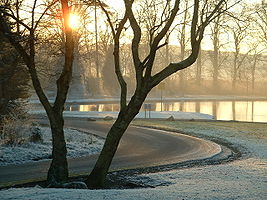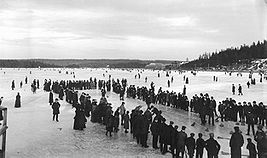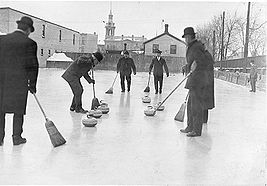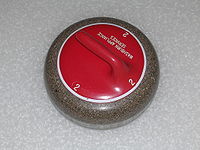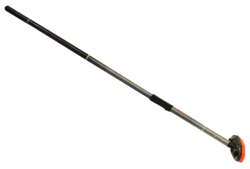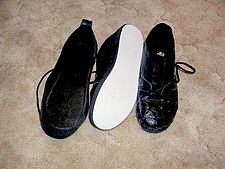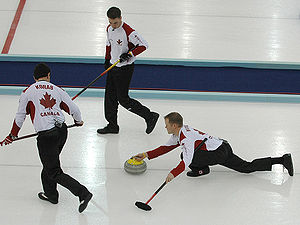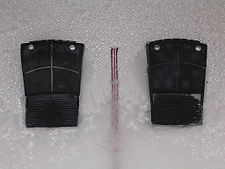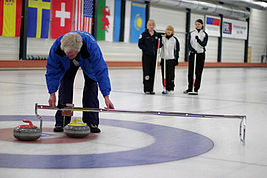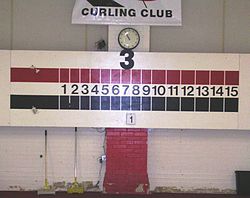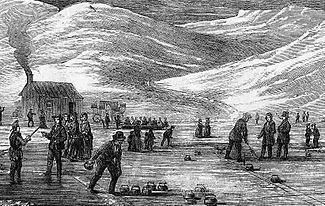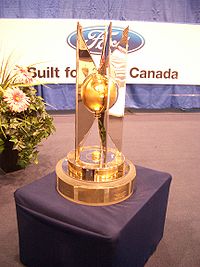- Curling
-
Curling 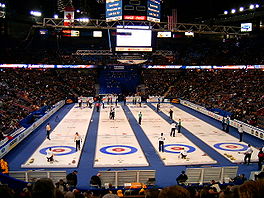
Highest governing body World Curling Federation Nickname(s) Chess On Ice, The Roaring Game First played Approximately late medieval Scotland Registered players 1,200,000 Characteristics Contact No Team members 4 per team (2 in Mixed Doubles) Mixed gender See mixed curling Categorization Precision and accuracy Equipment Curling brooms, stones (rocks), curling shoes Venue Curling sheet Olympic First event in 1924 (Retroactively made official in 2006).
Demonstration sport in 1932, 1988 and 1992.
Officially added in 1998.Paralympic Officially added in 2006.
See Wheelchair curlingCurling is a sport in which players slide stones across a sheet of ice towards a target area. It is related to bowls, boule and shuffleboard. Two teams, each of four players, take turns sliding heavy, polished granite stones, also called "rocks", across the ice curling sheet towards the house, a circular target marked on the ice.[1] Each team has eight stones. The purpose is to accumulate the highest score for a game; points are scored for the stones resting closest to the centre of the house at the conclusion of each end, which is completed when both teams have thrown all of their stones. A game may consist of ten or eight ends.
The curler can induce a curved path by causing the stone to slowly turn as it slides, and the path of the rock may be further influenced by two sweepers with brooms who accompany it as it slides down the sheet, using the brooms to alter the state of the ice in front of the stone. A great deal of strategy and teamwork goes into choosing the ideal path and placement of a stone for each situation, and the skills of the curlers determine how close to the desired result the stone will achieve. This gives curling its nickname of "Chess On Ice".[2][3]
Contents
Origins and history
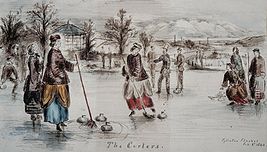 A curling match at Eglinton Castle, Ayrshire, Scotland in 1860. The Curling House is located to the left of the picture.
A curling match at Eglinton Castle, Ayrshire, Scotland in 1860. The Curling House is located to the left of the picture.
Curling is thought to have been invented in medieval Scotland, with the first written reference to a contest using stones on ice coming from the records of Paisley Abbey, Renfrewshire, in February 1541. Two paintings (both dated 1565) by Pieter Bruegel the Elder depict Dutch peasants curling—Scotland and the Low Countries had strong trading and cultural links during this period, which is also evident in the history of golf.
Evidence that curling existed in Scotland in the early 16th century includes a curling stone inscribed with the date 1511 (uncovered along with another bearing the date 1551) when an old pond was drained at Dunblane, Scotland.[4] Kilsyth Curling Club claims to be the first club in the world, having been formally constituted in 1716; it is still in existence today.[5] Kilsyth also claims the oldest purpose-built curling pond in the world at Colzium, in the form of a low dam creating a shallow pool some 100 × 250 metres in size, though this is now very seldom in condition for curling because of warmer winters.[citation needed]
The word curling first appears in print in 1620 in Perth, in the preface and the verses of a poem by Henry Adamson. The game was (and still is, in Scotland and Scottish-settled regions like southern New Zealand) also known as "the roaring game" because of the sound the stones make while traveling over the pebble (droplets of water applied to the playing surface). The verbal noun curling is formed from the Scots (and English) verb curl,[6] which describes the motion of the stone.
In the early history of curling, the playing stones (or rocks) were simply flat-bottomed river stones that were sometimes notched or shaped; the thrower, unlike those of today, had little control over the stone, and relied more on luck than on skill and strategy.
It is recorded that in Darvel, East Ayrshire, the weavers relaxed by playing curling matches. The stones they used were the heavy stone weights from the weavers' "warp beams," fitted with a detachable handle for the purpose. Many a wife would keep her husband's brass curling stone handle on the mantelpiece, brightly polished until the next time it was needed.[7]
Outdoor curling was very popular in Scotland between the 16th and 19th centuries, as the climates provided good ice conditions every winter. Scotland is home to the international governing body for curling, the World Curling Federation, Perth, which originated as a committee of the Royal Caledonian Curling Club, the mother club of curling.
Today, the game is most firmly established in Canada, having been taken there by Scottish emigrants. The Royal Montreal Curling Club, the oldest established sports club still active in North America,[8] was established in 1807. The first curling club in the United States began in 1830, and the game was introduced to Switzerland and Sweden before the end of the 19th century, also by Scots. Today, curling is played all over Europe and has spread to Japan, Australia, New Zealand, China, and Korea.[9]
The first world curling championship in the sport was limited to men and was known as the "Scotch Cup", held in Falkirk and Edinburgh, Scotland, in 1959. The first world title was won by the Canadian team from Regina, Saskatchewan, skipped by Ernie Richardson. (The skip is the team member who calls the shots; see below.)
The first curling club in the United States was organized in 1830 only 30 miles from Detroit, at Orchard Lake, Michigan. Called the Orchard Lake Curling Club, the club used hickory block "stones". The Detroit Curling Club was started in 1840 when Michigan only had a population of 212,000 and had only been in the Union for three years. About this time, an organization called the "Thistle Club" was founded and, curling being a winter sport, was played when the ice was suitable on the Detroit River at the foot of Joseph Campau; on the bay; and at the old Recreation Park. These clubs became the Granite Club, and in 1885, the present Detroit Curling Club was organized.
Olympic curling
Curling has been an official sport in the Winter Olympic Games since the 1998 Winter Olympics. In February 2002, the International Olympic Committee retroactively decided that the curling competition from the 1924 Winter Olympics (originally called Semaine des Sports d'Hiver, or International Winter Sports Week) would be considered official Olympic events and no longer be considered demonstration events. Thus, the first Olympic medals in curling, which at the time was played outside, were awarded for the 1924 Winter Games, with the gold medal won by Great Britain and Ireland, two silver medals by Sweden, and the bronze by France. A demonstration tournament was also held during the 1932 Winter Olympic Games between four teams from Canada and four teams from the United States, with Canada winning 12 games to 4.[10][11]
Equipment
The curling sheet
The playing surface or curling sheet is defined by the World Curling Federation Rules of Curling.[12] The sheet is an area of ice, carefully prepared to be as flat and level as possible, 146 to 150 feet (45 to 46 m) in length by 14.5 to 16.5 feet (4.4 to 5.0 m) in width.
A target, the house, is marked at each end of the sheet. The house consists of three concentric rings formed by painting or laying coloured vinyl sheet under the ice and are usually distinguished by colour. These rings are defined by their diameters as the four-foot, eight-foot and 12-foot rings. The rings are merely a visual aid for aiming and judging which stone is closer to the centre; they do not affect scoring but a stone must at least touch the outer ring or it does not score (see Scoring below).
Each house is centred on the intersection of the centre line, drawn lengthwise down the centre of the sheet and one of the tee lines, drawn 16 feet (4.9 m) from, and parallel to, each backboard. These lines divide the houses into quarters.
The centre of each house, at the intersection of the centre line and the tee line, is known as the button. Two hog lines, are drawn 37 feet (11 m) from, and parallel to, each backboard.
The hacks are fixed 12 feet behind each button; a hack gives the thrower something to push against when making the throw. On indoor rinks, there are usually two fixed hacks, rubber-lined holes, one on each side of the centre line, with the inside edge no more than 3 inches (76 mm) from the centre line and the front edge on the hack line. A single moveable hack may also be used.
The ice may be natural but is usually frozen by a refrigeration plant pumping a brine solution through numerous pipes fixed lengthwise at the bottom of a shallow pan of water. Most curling clubs have an ice maker whose main job is to care for the ice. At the major curling championships, ice maintenance is extremely important. Large events, such as the Brier or other national/international championships, are typically held in an arena that presents a challenge to the ice maker, who must constantly monitor and adjust the ice and air temperatures as well as air humidity levels to ensure a consistent playing surface. It is common for each sheet of ice to have multiple sensors embedded in order to monitor surface temperature, as well as probes set up in the seating area (to monitor humidity) and in the compressor room (to monitor brine supply and return temperatures).The surface of the ice is maintained at a temperature of around 23 °F (−5 °C).[13]
A key part of the preparation of the playing surface is the spraying of water droplets onto the ice, which form pebble on freezing. The pebbled ice surface resembles an orange peel, and the stone moves on top of the pebbled ice.[14] As the stone moves over the pebble, any rotation of the stone causes it to curl to the inside or outside; the amount of curl (commonly referred to as the feet of curl) can change during a game as the pebble wears. Due to this, the ice maker must also be aware of the pebble wear, and the ice will typically be scraped and re-pebbled prior to each game.[15]
Curling stone
The curling stone (also sometimes rock, North America), as defined by the World Curling Federation is a thick stone disc weighing between 38 and 44 pounds (17 and 20 kg) with a handle attached to the top.[12] The maximum allowable circumference is 36 inches (910 mm).[12] The minimum height is 4.5 inches (110 mm).[12] The handle is attached by a bolt running vertically through a hole in the centre of the stone. The handle allows the stone to be gripped and rotated upon release; on properly prepared ice, the stone's path will bend (curl) in the direction the front edge of the stone is turning, especially as the stone slows. The handles are colored to identify the stones by team. Two popular colors in major tournaments are red and yellow. The only part of the stone in contact with the ice is the running surface, a narrow, flat annulus or ring, 0.25 to 0.50 inch (6.3 to 13 mm) wide and about 5 inches (130 mm) in diameter; the sides of the stone bulge convex down to the ring and the inside of the ring is hollowed concave to clear the ice.
Traditionally, curling stones were made from two specific types of granite called "Blue Hone" and "Ailsa Craig Common Green", found on Ailsa Craig, an island off the Ayrshire coast in Scotland. Blue Hone has very low water absorption, which prevents the action of freezing and melting water from eroding the stone.[16] Ailsa Craig Common Green granite is a lesser quality granite than Blue Hone. In the past, most curling stones were made from Blue Hone; however, the island is now a wildlife reserve and the quarry has closed. The second location where granite comes from to manufacture curling stones from is in Northern Wales. This granite is called "Trefor" and comes in shades of blue/gray and red/brown. The quarry in Wales that supplies the granite to its exclusive curling stone manufacturing company in Canada, Canada Curling Stone Co., is a full and active quarry and it is not anticipated to ever run out of this granite for making curling stones. Canada Curling Stone Co. has been manufacturing curling stones since 1992. The cost of new Trefor granite curling stones is about C$600 a stone.
Kays of Scotland has been making curling stones since 1851 and has the exclusive rights to Ailsa Craig granite, granted by the Marquess of Ailsa, whose family has owned the island since 1560. The last "harvest" of Ailsa Craig granite by Kays took place in 2002. Kays have said that they harvested 1,500 tons, sufficient to fill anticipated orders through at least 2020. Kays has been the exclusive manufacturer of curling stones for all three Olympics where curling has been a medal sport.[17]
In competition, an electronic handle known as the eye on the hog may be fitted to detect hog line violations, the game's most frequent cause of controversy. This electronically detects whether the thrower's hand is in contact with the handle as it passes the hog line and indicates a violation by lights at the base of the handle. The eye on the hog eliminates human error and the need for hog line officials. It is mandatory in high-level national and international competition but its cost, around US$650 each, currently puts it beyond the reach of most social curling.
Curling broom
The curling broom, or brush, is used to sweep the ice surface in the path of the stone, (see "sweeping"), and is also often used as a balancing aid during delivery of the stone.
In earlier days, brooms were made of corn strands and were similar to household brooms. Brushes were used primarily by elderly curlers as a substitute for corn brooms. Today, brushes have replaced traditional corn brooms at every level of curling, but are universally referred to as brooms. Curling brushes may have fabric, hog hair, or horsehair heads. Modern curling broomsticks are usually hollow tubes made of fiberglass or carbon fiber instead of a solid length of wooden dowel. These hollow tube handles are lighter and stronger than wooden handles, allowing faster sweeping and also enabling more downward force to be applied to the broom head with reduced shaft flex.
Shoes
Curling shoes are similar to ordinary athletic shoes except that they have dissimilar soles; the slider shoe is designed for the off foot (or sliding foot) and the non-sliding shoe for the hack foot:
The slider shoe is designed to slide and typically has a Teflon sole. It is worn by the thrower during delivery from the hack and by sweepers or the skip to glide down the ice when sweeping or otherwise traveling down the sheet quickly. Stainless steel was once common for slider soles, and "red brick" sliders with lateral blocks of PVC on the sole are also available. Most shoes have a full-sole sliding surface, but some shoes have a sliding surface covering only the outline of the shoe and other enhancements with the full-sole slider. Some shoes have small disc sliders covering the front and heel portions or only the front portion of the foot, which allow more flexibility in the sliding foot for curlers playing with tuck deliveries.[18] When a player is not throwing, the player's slider shoe can be temporarily rendered non-slippery by using a slip-on gripper. Ordinary athletic shoes may be converted to sliders by using a step-on or slip-on Teflon slider or by applying electrical or gaffer tape directly to the sole or over a piece of cardboard. This arrangement often suits casual or beginning players.
The non-sliding shoe, or hack foot shoe, is worn by the thrower on the hack foot during delivery and is designed to grip. It may have a normal athletic shoe sole or a special layer of rubbery material applied to the sole of a thickness to match the sliding shoe. The toe of the hack foot shoe may also have a rubberised coating on the top surface or a flap that hangs over the toe to reduce wear on the top of the shoe as it drags on the ice behind the thrower.
Other equipment
Other types of equipment include:
-
- Curling pants, made to be stretchy to accommodate the curling delivery.
- A stopwatch to time the stones while sweeping to get a feel of the speed of the stone. Stopwatches can be attached either to clothing or the broom itself.
- Curling gloves and mittens, to keep the hands warm and improve grip on the broom.
Gameplay
International competitive games are ten ends, so most of the national championships that send a representative to the World Championships or Olympics also play ten ends. However, there is a movement on the World Curling Tour to make the games only eight ends.[citation needed] Most tournaments on that tour are like the vast majority of recreation games, and are eight ends. An end consists of each player from both teams throwing two stones down the sheet with the players on each side alternating shots, for a total of 16 stones. A game may be conceded if considered unwinnable. If the teams are tied play continues for as many ends as may be required to break the tie. The winner is the team with the highest score after all ends have been completed (see Scoring below).
In international competition, each side is given 73 minutes to complete all of its throws. Each team is also allowed two 60-second timeouts per 10-end game. If extra ends are required, each team is allowed 10 minutes of playing time to complete its throws and one added 60-second timeout for each extra end.
Delivery
The process of sliding a stone down the sheet is known as the delivery.
The skip will usually determine the required weight, turn and line of the stone. These will be influenced by the tactics at this point in the game, which may involve taking-out, blocking or tapping another stone.
- The weight of the stone is its velocity, which depends on the leg drive of the delivery rather than the arm.
- The turn, handle, or curl is the rotation of the stone, which gives it a curved trajectory.
- The line is the direction of the throw ignoring the effect of the turn.
The skip may communicate the weight, turn, line and other tactics by calling or tapping a broom on the ice. In the case of a takeout, guard or a tap, the skip will indicate the stones involved.
Before delivery, the running surface of the stone is wiped clean and the path across the ice swept with the broom if necessary because any dirt on the bottom of a stone or in its path can alter the trajectory and ruin the shot. This is called a pick up or pick.
The thrower throws from the hack. Another player, usually the skip, is stationed behind the button to determine the tactics, weight, turn and line and the other two may sweep in front of the stone to influence the trajectory (see Sweeping, below). When the skip throws, the third takes his role.
The thrower's gripper shoe (with the non-slippery sole) is positioned against one of the hacks; for a right-handed curler the right foot is placed against the left hack and vice-versa for a left-hander. The thrower, now in the hack, lines the body up with shoulders square to the skip's broom at the far end for line.
The stone is placed in front of the foot now in the hack. Rising slightly from the hack the thrower pulls the stone back to the toe (some older curlers may actually raise the stone in this backward movement) then lunges smoothly out from the hack pushing the stone ahead while the slider foot is moved in front of the gripper foot, which trails behind. The thrust from this lunge determines the weight and hence the distance the stone will travel. While not compulsory, most curlers deliver the stone while sliding out from the hack. Balance may be assisted by a broom held in the free hand with the back of the broom down so that it slides.
The stone is released as the thrower's momentum wanes, or the hog line is approached, at which point the turn is imparted by a slight clockwise or anti-clockwise twist of the handle from around the two or ten o'clock position to the 12 o'clock on release. A typical rate of turn is about 2½ rotations before coming to a rest.
The stone must be released before its front edge crosses the near hog line and it must clear the far hog line or else be removed from play (hogged); an exception is made if a stone fails to come to rest beyond the far hog line after rebounding from a stone in play just past the hog line. The release rule is rarely enforced in club play unless abuse is suspected, however in major tournaments it is strictly enforced; the "eye on the hog" sensor in the stone will indicate whether the stone has been legally thrown or not. If the lights on the stone turn red the stone will be immediately pulled from play instead of waiting for the stone to come to rest.
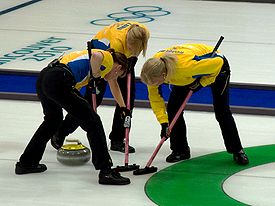 The front end of Team Sweden has been joined by the skip in sweeping a stone into the house at the 2010 Winter Olympic Games in Vancouver
The front end of Team Sweden has been joined by the skip in sweeping a stone into the house at the 2010 Winter Olympic Games in Vancouver
Sweeping
After the stone is delivered its trajectory is still influenced by the two sweepers under instruction from the skip. Sweeping is done for two reasons: to reduce friction underneath the stone, and to decrease the amount of curl. The stones curl more as they slow down, so sweeping early in travel tends to increase distance as well as straighten the path, and sweeping after sideways motion is established can increase the sideways distance. When sweeping, pressure and speed of the brush head are key in slightly increasing the layer of moisture that builds up under the stone.
One of the basic strategy aspects of curling is knowing when to sweep. When the ice in front of the stone is swept, a stone will usually travel both farther and straighter. In some situations, one of the two alterations in path is not desirable. For example, a stone may have too much weight, but require sweeping to prevent curling into a guard. The team must decide which is better: getting by the guard but traveling too far, or hitting the guard.
Much of the yelling that goes on during a curling game is the skip calling the line of the shot and the sweepers calling the weight. The skip evaluates the path of the stone and calls to the sweepers to sweep as necessary to maintain the intended track. The sweepers themselves are responsible for judging the weight of the stone, ensuring the length of travel is correct and communicating the weight of the stone back to the skip. Some teams use stopwatch timing, from back line to the nearest hog line as a sweeping aid. Many teams use the Number System to communicate in which of 10 playable zones it is estimated the stone will stop.
Usually, the two sweepers will be on opposite sides of the stone’s path, although depending on which side the sweepers’ strengths lie this may not always be the case. Speed and pressure are vital to sweeping. In gripping the broom, one hand should be one third of the way from the top (non-brush end) of the handle while the other hand should be one third of the way from the head of the broom. The angle of the broom to the ice should be so that the most force possible can be exerted on the ice. The precise amount of pressure may vary from relatively light brushing "just cleaning" (to ensure debris will not alter the stone’s path) to maximum-pressure scrubbing.
Sweeping is allowed anywhere on the ice up to the tee line, as long as it is only for one’s own team stones. Once the leading edge of a team stone crosses the tee line only one player may sweep it. Additionally, when a stone crosses the tee line, one player from the other team is allowed to sweep it. This is the only case that a stone may be swept by an opposing team member. In international rules, this player must be the skip; or if the skip is throwing, then the sweeping player must be the third.
'Burning' a stone
Occasionally, players may accidentally touch a stone with their broom or a body part. This is often referred to as "burning" a stone. Players touching a stone in such a manner are expected to call their own infraction (see Good sportsmanship). Touching a stationary stone when no stones are in play (there is no delivery in progress) is never an infraction and is a common way to indicate where a stone that is to be taken out should be struck.
When a stone is touched when stones are in play, the remedies vary[12][19] between placing the rocks as they end up after the touch, replacing the rocks as they would have been if no rock were touched, or removal of the touched rock from play. The rules generally dictate that the resulting outcome should be the one that places the touching team at the greatest possible disadvantage.
Types of shots
Many different types of shots are used to carefully place stones for strategic or tactical reasons; they fall into three fundamental categories as follows:
Guards are thrown in front of the house in the free guard zone, usually to protect the shot-rock (the stone closest to the button at the time) or to make the opposing team's shot difficult. Guard shots include the centre-guard, on the centreline and thecorner-guards to the left or right sides of the centre line. See Free Guard Zone below.
Draws are thrown only to reach the house. Draw shots include raise and angle-raise, come-around, and freeze shots.
Takeouts are intended to remove stones from play and include the peel, hit-and-roll and double shots.
For a more complete listing, look at the complete list Glossary of curling terms.
Free guard zone
Until four stones have been played (two from each side), stones in the free guard zone (those stones left in the area between the hog and tee lines, excluding the house) may not be removed by an opponent's stone. These are known as guard rocks. If the guard rocks are removed, they are replaced to where they were before the shot was thrown, and the opponent's stone is removed from play and cannot be replayed. This rule is known as the four-rock rule or the free guard zone rule (for a while in Canada, a "three-rock rule" was in place, but that rule has been replaced by the four-rock rule).
Originally, the Modified Moncton Rule was developed from a suggestion made by Russ Howard for a cashspiel (with the richest prize ever awarded at the time in a tournament) in Moncton, New Brunswick, in 1991. "Howard's Rule" (also known as the Moncton Rule), used for the tournament and based on a practice drill his team used, had the first four rocks in play unable to be removed no matter where they were at any time during the end. This method of play altered slightly and adopted as a Four-rock Free Guard Zone for international competition shortly after. Canada kept to the traditional rules until a three-rock Free Guard Zone rule was adopted, starting in the 1993-94 season. After several years of having the three-rock rule used for the Canadian championships and the winners then having to adjust to the four-rock rule in the World Championships, the Canadian Curling Association adopted the now-standard Free Guard Zone in the 2002-2003 season.
This rule, a relatively recent addition to curling, was added in response to a strategy of "peeling" opponents' guard stones (knocking them out of play at an angle that caused the shooter's stone to also roll out of play, leaving no stones on the ice). A team in the lead would often employ this strategy during the game. By knocking all stones out, the opponents could at best score one point (if they had the hammer). Alternatively, the team with the hammer could peel rock after rock, which would blank the end, keeping the last rock advantage for another end. This strategy had developed (mostly in Canada) as ice-makers had become skilled at creating a predictable ice surface and the adoption of brushes allowed greater control over the rock. While a sound strategy, this made for an unexciting game. The 1990 Brier was considered by many curling fans as boring to watch because of the near-constant peeling, and the quick adoption of the Free Guard Zone the following year reflected how disliked this aspect of the game had become.
One strategy that has been developed by curlers in response to the Free Guard Zone (Kevin Martin from Alberta is one of the best examples) is the "tick" game, where a shot is made attempting to knock (tick) the guard to the side, far enough that it is difficult or impossible to use but still remaining in play while the shot itself goes out of play. The effect is functionally identical to peeling the guard but significantly harder, as a shot that hits the guard too hard (knocking it out of play) results in its being replaced, while not hitting it hard enough can result in its still being tactically useful for the opposition. There's also a greater chance that the shot will miss the guard entirely because of the greater accuracy required to make the shot. Because of the difficulty of making this type of shot, only the best teams will normally attempt it, and it does not dominate the game the way the peel formerly did. Steve Gould from Manitoba popularized ticks played across the face. These are easier to make because they impart less speed on the object stone, therefore increasing the chance that it remains in play even if a bigger chunk of it is hit.
Hammer
Last-rock or last-stone advantage in an end is called the hammer. Before the game, teams typically decide who gets the hammer in the first end either by chance (such as a coin toss), by a "draw-to-the-button" contest, where a representative of each team shoots a single stone to see who gets closer to the centre of the rings, or, particularly in tournament settings like the Winter Olympics, by a comparison of each team's win-loss record. In all subsequent ends, the hammer belongs to the team that did not score in the preceding end. In the event that neither team scores, the hammer remains with the same team. Naturally, it is easier to score points with the hammer than without; in tournament play, the team with the hammer generally tries to score two or more points. If only one point is possible, the skip will often try to avoid scoring at all in order to retain the hammer until the next end, when two or more points may lie. This is called a blank end. Scoring without the hammer is commonly referred to as stealing, or a steal, and is much more difficult.
Strategy
Curling is a game of strategy, tactics and skill. The strategy depends on the team's skill, the opponent's skill, the conditions of the ice, the score of the game, how many ends remain and whether the team has last-stone advantage (the hammer). A team may play an end aggressively or defensively. Aggressive playing will put a lot of stones in play by throwing mostly draws; this makes for an exciting game and is very risky but the reward can be very great. Defensive playing will throw a lot of hits preventing a lot of stones in play; this tends to be less exciting and less risky. A good drawing team will usually opt to play aggressively, while a good hitting team will opt to play defensively.
If a team does not have the hammer in an end, it will opt to try and clog up the four-foot zone in the house to deny the opposing team access to the button. This can be done by throwing "centre line" guards in front of the house on the centre line, which can be tapped into the house later or drawn around. If a team has the hammer, they will try to keep this four-foot zone free so that they have access to the button area at all times. A team with the hammer may throw a corner guard as their first stone of an end placed in front of the house but outside the four-foot zone to utilize the free guard zone. Corner guards are key for a team to score two points in an end, because they can either draw around it later or hit and roll behind it, making the opposing team's shot to remove it more difficult.
Ideally, the strategy in an end for a team with the hammer is to score two points or more. Scoring one point is often a wasted opportunity, as they will then lose last-rock advantage for the next end. If a team can't score two points, they will often attempt to "blank an end" by removing any leftover opposition rocks and rolling out; or, if there are no opposition rocks, just throwing the rock through the house so that no team scores any points, and the team with the hammer can try again the next end to score two or more with it. Generally, a team without the hammer would want to either force the team with the hammer to only one point (so that they can get the hammer back) or "steal" the end by scoring one or more points of their own.
Generally, the larger the lead a team will have in a game, the more defensively they should play. By hitting all of the opponent's stones, it removes opportunities for their getting multiple points, therefore defending the lead. If the leading team is quite comfortable, leaving their own stones in play can also be dangerous. Guards can be drawn around by the other team, and stones in the house can be tapped back (if they are in front of the tee line) or frozen onto (if they are behind the tee line). A frozen stone is difficult to remove, because it is "frozen" (in front of and touching) to the opponents stone. At this point, a team will opt for "peels", meaning that the stones they throw will be to not only hit their opposition stones, but to roll out of play as well. Peels are hits that are thrown with the most amount of power.
Conceding a game
It is not uncommon at any level for a losing team to terminate the match before all ends are completed if it believes it no longer has a realistic chance of winning. Playoff games at national and world championships require eight ends to be completed before allowing a losing team to concede in this manner. Competitive games will usually end once the losing team has "run out of rocks"—that is, once it has fewer stones in play and/or available for play than the number of points needed to tie the game in the final end.
When a team feels it is impossible or near impossible to win a game, they will usually shake hands with the opposing team to concede defeat. This may occur at any point during the game, but usually happens near the final end. In the Winter Olympics, a team may concede after finishing any end during a round-robin game, but can only concede after finishing eight ends during the knockout stages.
Unlike other sports, there is no negative connotation associated with conceding in curling. In fact, in many competitions, a team is required to concede when it is mathematically impossible for them to tie a game. In more social situations, it is often considered a breach of etiquette (or at least looked down upon) to keep playing when the game is well out of reach.
Dispute resolution
Most decisions about rules are left to the skips, although in official tournaments, decisions may be left to the officials. However, all scoring disputes are handled by the third, or vice skip. No players other than the third from each team should be in the house while score is being determined. In tournament play, the most frequent circumstance in which a decision has to be made by someone other than the third is the failure of the thirds to agree on which stone is closest to the button. An independent official (supervisor at Canadian and World championships) then measures the distances using a specially designed device that pivots at the centre of the button. When no independent officials are available, the thirds measure the distances.
Scoring
The winner is the team having the highest number of accumulated points at the completion of ten ends. Points are scored at the conclusion of each of these ends as follows: when each team has thrown its eight stones the team with the stone closest to the button wins that end, the winning team is then awarded one point for each of its own stones lying closer to the button than the opponent's closest stone. The positions of all the other opponent’s stones other than the closest make no difference to the score.
Only stones that are in the house are considered in the scoring. A stone is in the house if it lies within the 12-foot (3.7 m) zone or any portion of its edge lies over the edge of the ring. Since the bottom of the stone is rounded, a stone just barely in the house will not have any actual contact with the ring, which will pass under the rounded edge of the stone, but it still counts. This type of stone is known as a biter.
It may not be obvious to the eye which of two rocks is closer to the button (center) or if a rock is actually biting or not. There are specialized devices to make these determinations, but these cannot be brought out until after an end is completed. Therefore, a team may make strategic decisions during an end based on assumptions of rock position that turn out to be incorrect.
The score is marked on a scoreboard, of which there are two types; the baseball type and the club scoreboard.
The baseball-type scoreboard was created for televised games for audiences not familiar with the club scoreboard. The ends are marked by columns 1 through 10 (or 11 for the possibility of an extra end to break ties) plus an additional column for the total. Below this are two rows, one for each team, containing the team's score for that end and their total score in the right hand column.
The club scoreboard is traditional and used in most curling clubs. Scoring on this board only requires the use of (up to) 11 digit cards, whereas with baseball-type scoring an unknown number of multiples of the digits (especially low digits like 1) may be needed. The numbered centre row represents all possible accumulated scores, the numbers placed in the team rows represents the end in which that team achieved that cumulative score. If the red team scores three points in the first end (called a three-ender), then a 1 (indicating the first end) is placed beside the number 3 in the red row. If they score two more in the second end, then a 2 will be placed beside the 5 in the red row, indicating that the red team has five points in total (3+2). This scoreboard works because only one team can get points in an end. However, some confusion may arise if neither team scores points in an end, this is called a blank end. The blank end numbers are usually listed in the farthest column on the right in the row of the team that has the hammer (last rock advantage), or on a special spot for blank ends.
The following example illustrates the difference between the two types. The example illustrates the men's final at the 2006 Winter Olympics.
Baseball-style scoreboard Team 1 2 3 4 5 6 7 8 9 10 Final  Canada
Canada0 2 1 1 0 6 0 0 x x 10  Finland
Finland2 0 0 0 1 0 0 1 x x 4 Curling club-style scoreboard  Canada
Canada2 3 4 6 Points 1 2 3 4 5 6 7 8 9 10 11 12 13 14 15 Blank ends  Finland
Finland1 5 8 7 Eight points – all the rocks thrown by one team counting – is the highest score possible in an end, and is known as an "eight-ender" or "snowman". Scoring an eight-ender against a relatively competent team is very difficult; in curling, it is considered the equivalent of pitching a perfect game in baseball. Probably the best-known snowman came at the 2006 Players' Championships. Future (2007) World Champion Kelly Scott scored eight points in one of her games against 1998 World bronze medalist Cathy King.[20][21]
Curling culture
Competition teams are normally named after the Skip, for example, Team Martin for skip Kevin Martin. Amateur league players can (and do) creatively name their teams, but when in competition (a bonspiel) the official team will have a standard name.
Top curling championships are typically played by all-male or all-female teams. The game is known as mixed curling when a team consists of two men and two women. The Canadian Mixed Curling Championship is the highest-level mixed curling competition, in the absence of world championship or Olympic mixed curling events.
Curling is played in many countries including Canada, United Kingdom (especially Scotland), the United States, Norway, Sweden, Switzerland, Denmark, Finland and Japan, all of which compete in the world championships.
Curling is particularly popular in Canada. Improvements in ice making and changes in the rules to increase scoring and promote complex strategy have increased the already high popularity of the sport in Canada, and large television audiences watch annual curling telecasts, especially the Scotties Tournament of Hearts (the national championship for women), the Tim Hortons Brier (the national championship for men), and the women's and men's world championships.
Despite the Canadian province of Manitoba's small population (ranked 5th of 10 Canadian provinces), Manitoban teams have won the Brier more times than teams from any other province. The Tournament of Hearts and the Brier are contested by provincial and territorial champions, and the world championships by national champions.
Curling is the provincial sport of Saskatchewan. From there Ernie Richardson and his family team dominated Canadian and international curling during the late 1950s and early 1960s and have been considered to be the best male curlers of all time.[22] Sandra Schmirler led her team to the first ever gold medal in women's curling in the 1998 Winter Olympics. When she died two years later from cancer, over 15,000 people attended her funeral, and it was broadcast on national television.
An amateur sport
While Canadian bonspiels (tournaments) offer cash prizes, there are very few full-time professional curlers. However, some curlers make a considerable portion of their income from curling. Still, curling survives as a people's sport, returning to the Winter Olympics in 1998 with men's and women's tournaments after not having been on the official Olympic program since 1924 (that year's curling competition, for men only, was confirmed as official by the IOC in 2006). Because accuracy, strategy, skill, and experience are more valuable in curling than traditional sports virtues of speed, stamina, and strength, most competitive curlers are older than their counterparts in other sports. However, there are many young teams who turn heads, and junior curling is quite popular, with national finals being televised nationwide in Canada.
Good sportsmanship
More so than in many team sports, good sportsmanship is an integral part of curling. Even at the highest levels of play, players are expected to "call their own fouls", so to speak, such as alerting the opposing skip if they "burned" a stone. A match traditionally begins with players shaking hands and saying "Good Curling" to each member of the opposing team. It is also traditional for the winning team to buy the losing team a drink after the game.[23] This is often referred to as the Spirit of Curling. This tradition is in contrast to the games of darts where the loser traditionally buys the winner a drink by way of congratulations.
As noted above in the game play section, it is not uncommon for a team to concede a curling match after it believes it no longer has a reasonable chance of winning but before all ends are completed. Concession is an honourable act and does not carry the stigma associated with quitting, and allows for more socializing. To concede a match, members of the losing team remove their curling gloves (if they wear them) and offer congratulatory handshakes to the winning team. Thanks and wishes of future good luck are usually exchanged between the teams.
Special needs in curling
Curling has been adapted for wheelchair users and people otherwise unable to throw the stone from the hack. These curlers may use a special device known as a "curler's cue" or "delivery stick". The cue holds on to the handle of the stone and is then pushed along by the curler. At the end of delivery, the curler pulls back on the cue, which releases it from the stone. The Canadian Curling Association Rules of Curling allows the use of a delivery stick in club play but does not permit it in championships.
Terminology
Terms used to describe the game include:
The ice in the game may be fast or slow. If the ice is fast, a rock will travel farther with a given amount of weight (throwing force) on it. The speed of the ice is measured in seconds. One such measure known as "hog-to-tee" is the amount of time that a rock will take from the moment that it crosses the hog line at the throwing end to come to rest at the tee line at the playing end. If the ice is slow, the rock will have to have more weight in order to reach the tee line and would reach the tee line more quickly. Increasing the weight of the rock will increase the momentum of the rock. Thus, the speed of the ice (in seconds) is lower if the ice is slow than if the ice is fast, in which case the rock would have to be thrown more slowly and would take longer to get there. The time is longer because the stone takes longer to slow down the keener the ice.
The "hog-to-hog" speed is the speed of the stone and is the time in seconds the rock takes from the moment it crosses the near hog line till it crosses the far hog line. If this number is lower, the rock is moving faster, so again low numbers mean more speed. The ice in a match will be somewhat consistent and thus this measure of speed can also be used to measure how far down the ice the rock will travel. Once it is determined that a rock taking (for example) 9 seconds to go from hog line to hog line will stop on the tee line, the curler can know that if the hog-to-hog time is matched by a future stone, that stone will likely stop at approximately the same location. As an example, on keen ice, common times might be 16 seconds for guards, 14 seconds for draws, and 9 seconds for peel weight.
The back line to hog line speed is used principally by sweepers to get an initial sense of the weight of a stone. As an example, on keen ice, common times might be 4.0 seconds for guards, 3.8 seconds for draws, 3.2 for normal hit weight, and 2.9 seconds for peel weight. Especially at the club level, this metric can be misleading, due to amateurs sometimes pushing stones on release, causing the stone to travel faster than the back-to-hog speed.
In popular culture
- The 2002 Canadian film Men With Brooms, starring and directed by Paul Gross, centres on the sport of curling, telling the story of a curling team from a small Canadian town as they work through their respective life issues and struggle to win the championship for the sake of their late coach. The film grossed over $4.2 million, all of it in Canada, making it the top-grossing Canadian English film subsidized by Telefilm Canada between 1997 and 2002.
See also
- European Curling Championships
- Grand Slam
- List of curlers
- United States Curling Association
- University and college curling
Champions and major championships
- List of World Curling Women's Champions
- List of World Curling Men's Champions
- Curling at the Winter Olympics
- World Curling Championship
- World Junior Curling Championships
- World Senior Curling Championships
- Continental Cup of Curling
- European Curling Championships
- European Mixed Curling Championships
- Pacific Curling Championships
- Scotties Tournament of Hearts
- Tim Hortons Brier
- Canadian Junior Curling Championships
- Canadian Mixed Curling Championship
- Canadian Senior Curling Championships
- Canada Cup
- United States Curling Men's Championships
- United States Curling Women's Championships
- United States Junior Men's Championships
- United States Junior Women's Championships
- United States Olympic Curling Trials
- The Dominion Curling Club Championships
- U.S. intercollegiate curling champions
Notable curling clubs
Main article: List of curling clubsNotable curling clubs- Bemidji Curling Club – Bemidji, Minnesota, Home of the 2006 United States Men's & Women's Olympic Curling Teams
- Broomstones Curling Club – Wayland, Massachusetts
- Blackhawk Curling Club – Janesville, Wisconsin
- Cape Cod Curling Club – Falmouth, Massachusetts
- Chicago Curling Club – Chicago, Illinois
- Columbus Curling Club – Columbus, Ohio – One of the United States' newest clubs
- Copper Country Curling Club – Calumet, Michigan – The only indoor curling club in the United States that curls on unrefrigerated, natural ice
- Curling Club Utrecht – Utrecht, Netherlands
- Dakota Curling Club – Burnsville, Minnesota – a leading example of the development of new curling clubs on arena ice in the USA
- Detroit Curling Club – Ferndale, Michigan
- Duluth Curling Club- Duluth, Minnesota – Largest curling facility in the United States
- Garrison Golf and Curling Club, Kingston, Ontario
- Grand National Curling Club – Organization in the United States covering clubs on the east coast
- Granite Curling Club – Winnipeg, Manitoba
- Granite Curling Club – Seattle, Washington, the only dedicated curling facility on the west coast of the United States
- Greenacres Curling Club, Scotland – Home of the Salt Lake City Olympics gold medal winning Ladies team of 2002.
- Hollywood Curling Club, Los Angeles, CA – Home of one of the newest curling clubs in the United States
- Fenton's Rink – the first curling rink in England
- South of England Curling Club (SECC) – Active club in South England
- Ice Melters Curling Club – England
- KC Curling Club – Kansas City
- KW Granite Curling Club – Waterloo, Ontario
- Markinch Curling Club – Fife, Scotland
- Mayflower Curling Club – Halifax, Nova Scotia
- Milwaukee Curling Club – Mequon, Wisconsin — The oldest curling club in the U.S. – Since 1845
- Nutmeg Curling Club – Bridgeport, Connecticut
- Ottawa Curling Club – Ottawa, Ontario
- Potomac Curling Club – Laurel, Maryland – Near Washington, D.C
- Philadelphia Curling Club – Paoli, Pennsylvania – Established in 1957
- Pittsburgh Curling Club – Pittsburgh, Pennsylvania – Established in 2002
- Plainfield Curling Club – South Plainfield, New Jersey
- Rideau Curling Club – Ottawa, Ontario
- Royal Caledonian Curling Club – Scotland, the official Mother Club of curling
- Royal Montreal Curling Club – Montreal, Quebec, the oldest active athletic club in North America
- Royal City Curling Club – New Westminster, British Columbia
- Saint Paul Curling Club – St. Paul, Minnesota – Founded in 1885. Club with largest active membership in the United States (over 1000 members).
- Schenectady Curling Club – Schenectady, New York – Established 1907 – Home to the Gordon Medal
- Utica Curling Club – Utica, New York
- Waltham Curling Club – Triumph, Illinois: The Oldest Curling Club in Illinois (Est. 1884)
- Windsor Curling Club – Windsor, Nova Scotia
- Roseland Golf and Curling Club – Windsor, Ontario
- Wauwatosa Curling Club – Wauwatosa, Wisconsin – Home of 2005 U.S. Women's Olympic Curling Team coach.
- Kilsyth – the first constituted curling club in the world
- Wausau Curling Club – Wausau, Wisconsin – Home of the Tietge Bonspiel, the oldest and largest high school curling bonspiel in the U.S.
Notes
- ^ Wetzel, Dan. (February 19, 2010) Don’t take curling for granite Yahoo! Sports.
- ^ "‘Chess on ice’". Princeton Allumni Weekly. 2009-01-28. http://paw.princeton.edu/issues/2009/01/28/pages/5296/index.xml. Retrieved 2010-10-10.
- ^ "Chess on ice". The Curling News. 2007-06-22. http://curlnews.blogspot.com/2007/06/chess-on-ice.html. Retrieved 2010-10-10.
- ^ "Wooden Curling Stone". Wisconsin Historical Society. 2006-02-23. http://www.wisconsinhistory.org/museum/artifacts/archives/002022.asp. Retrieved 2010-10-14.
- ^ Kilsyth Curling History
- ^ SND
- ^ Nate Baker (Editor), The Book of Old Darvel and Some of its Famous Sons. Pub. Walker & Connell, Darvel. P. 12–13.
- ^ "The Royal Montreal Curling Club"
- ^ "WCF rankings"
- ^ "III Winter Olympic Games, Lake Placid 1932, Official Report". 1932. pp. 255–258. http://www.la84foundation.org/6oic/OfficialReports/1932/1932w.pdf. Retrieved 2008-08-14
- ^ "CANADIANS WIN AT CURLING.; Beat United States, 12 Games to 3, in Exhibition Series". The New York Times. 1932-02-06. pp. SPORTS, Page 20. http://select.nytimes.com/gst/abstract.html?res=F20910F8355B13738DDDAF0894DA405B828FF1D3. Retrieved 2008-08-13.
- ^ a b c d e "The Rules of Curling and Rules of Competition". World Curling Federation. 2008-06. http://www.worldcurling.org/rules-and-regulations. Retrieved 2010-03-07.
- ^ Branch, John. "Curlers Are Finicky When It Comes to Their Olympic Ice", The New York Times, Monday, August 17, 2009.
- ^ "USA-Today: Curlers Play Nice and Leave No Stone Unturned". Twin Cities Curling Association. http://www.twincitiescurling.org/press_release/usa_today_021704.html.
- ^ "Smooth operators: They make Olympic ice nice". MSNBC Today in Vancouver. 23 February 2010. http://today.msnbc.msn.com/id/35537168/ns/today-today_in_vancouver/t/smooth-operators-they-make-olympic-ice-nice/#.TkTMOL9e4TU.
- ^ Anchorage Curling Club – About Curling/Stones
- ^ Kays of Scotland: About us
- ^ "Curling Shoes:Choosing a Slider". http://glennpaulley.ca/curling/2011/05/22/curling-shoes-choosing-a-slider/.
- ^ "Rules of Curling for General Play". Canadian Curling Association. 2007-09. http://media.curling.ca/contentImages/File/2007-2008%20General%20Rules%20of%20Play.pdf. Retrieved 2010-03-07.
- ^ "Shooting Percentages" on CurlingZone
- ^ "Curling 8 Ender". You Tube. http://www.youtube.com/watch?v=VC6Dap35B_Y. Retrieved 2010-10-20.
- ^ CBC Television, Kings of the World: The Curling Richardsons (March 13, 2004).
- ^ Pearson, Patricia (March/April 2009). "How one woman fell in love with curling". http://www.besthealthmag.ca/get-healthy/fitness/how-one-woman-fell-in-love-with-curling. Retrieved 2010-02-01.
External links
- World Curling Federation
- CBC Digital Archives – Curling: Sweeping the Nation
- Bonspiel! The History of Curling in Canada at Library and Archives Canada
- Curling Almanac
- curling stones, Smithsonian Center for Folklife and Cultural Heritage.
- The Game Of The Magic Broom, March 1944 one of the first magazine articles to introduce the game of curling to the American public
- The Canadian Curler's Manual transcription of 1840 text
Bowling Bolas criollas · Ten-pin · Nine-pin · Five-pin · Skittles · Candlepin · Duckpin · Feather · Bocce · Cantabrian bolo palma · Bowls · Pétanque · Kubb · Mölkky · Irish road bowling · Basque bowling · Kegel · Turkey · Boccia · Curling (Wheelchair)Olympic sports Summer sports Archery • Athletics • Badminton • Basketball • Boxing • Canoeing • Cycling • Diving • Equestrian • Field hockey • Fencing • Football • Gymnastics • Handball • Judo • Modern pentathlon • Rowing • Sailing • Shooting • Swimming • Synchronized swimming • Table tennis • Taekwondo • Tennis • Triathlon • Volleyball • Water polo • Weightlifting • Greco-Roman Wrestling
Winter sports Alpine skiing • Biathlon • Bobsleigh • Cross-country skiing • Curling • Figure skating • Freestyle skiing • Ice hockey • Luge • Nordic combined • Short track speed skating • Skeleton • Ski jumping • Snowboarding • Speed skating
Former Olympic sports Baseball • Basque pelota • Cricket • Croquet • Golf • Jeu de paume • Lacrosse • Polo • Rackets • Roque • Rugby union • Softball • Tug of war • Water motorsports
Part of the 2016 program See also: Paralympic sports Categories:- Curling
- Olympic sports
- Sports originating in Scotland
- Precision sports
- Team sports
-
Wikimedia Foundation. 2010.

